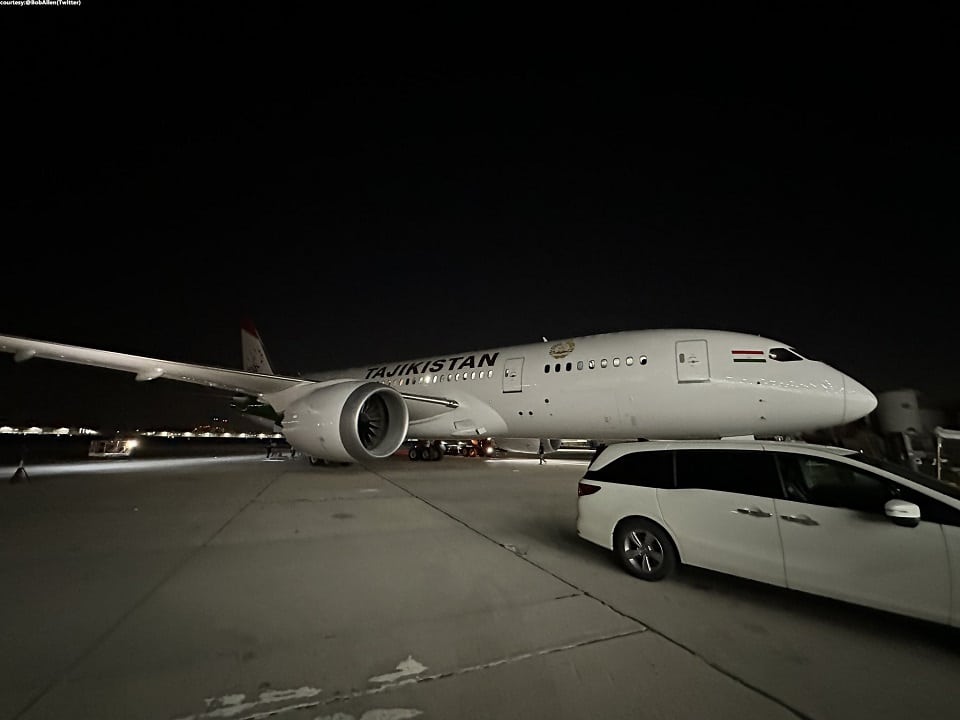Airlines
Mexico’s Lavish $92 Million Presidential Plane Arrives at Its New Home in Tajikistan

A luxurious presidential plane that Mexico had been trying to sell for over four years has finally landed in its new home – Tajikistan.
Last month, Mexican President Andrés Manuel López Obrador announced a $92 million sale of the presidential Boeing 787 to Tajikistan. According to data from FlightAware, the presidential jet, which was being housed in San Bernardino, California, departed from that state early on Sunday and touched down in Dushanbe, the capital of Tajikistan, at around 7:30 a.m. local time on Monday.
Regarding the purchase of the aircraft, the Tajik government has not yet provided any details. It is evident that the “Boeing 787-8 Dreamliner” aircraft was purchased expressly for the journeys of President Emomali Rahmon based on the painting and publication of the Tajik state emblems on the aircraft.
The Boeing 787 Dreamliner was sold for $92 million, while the original cost is $218 million, according to the President of the Republic of Mexico Lopez Obrador tweet.
Iberia unveils new Lavish cabin interior for its A350(Opens in a new browser tab)
The President of the Republic of Mexico announced that they will use the proceeds from the plane to build a hospital in the underdeveloped provinces of Guerrero and Oaxaca. This announcement sparked a great deal of discussion in Tajikistan and elsewhere.
While the plane’s interior is luxurious, with a presidential bedroom and marble and mahogany finishes, the fact that it was adapted to seat only 80 passengers makes it an exceptionally expensive form of transport per passenger.

Airlines
Air India Rolls Out A350s for Delhi-New York JFK and Newark Routes

In a major development for North American travelers, Air India has announced the deployment of its state-of-the-art Airbus A350-900 aircraft on two key routes: Delhi to New York and Delhi to Newark.
The service on the Delhi-New York route will commence on November 1, 2024, while the Delhi-Newark route will see its inaugural flight on January 2, 2025.
The introduction of the air india a350 will bring significant enhancements to Air India’s offerings, particularly with the launch of its Premium Economy class. air india retrofit This new class will feature 24 wide seats arranged in a 2-4-2 configuration, providing passengers with extra legroom and a more comfortable flying experience.
Soon, Air India aircraft will feature onboard WiFi & all-new cabins: Click here
“We are encouraged by the positive guest feedback we have received from the domestic deployment of our air india a350 interior to offer our hero product on the Delhi-New York JFK and Delhi-Newark routes. This is a significant leap forward for our U.S. operations that also underscores our commitment to continuous improvement,” said Campbell Wilson, Chief Executive Officer & Managing Director of Air India.
The A350’s Business class will set new standards with 28 private suites, each equipped with full-flat beds, direct aisle access, and personal wardrobes. Economy class will be configured to accommodate 264 passengers in a 3-4-3 layout. Across all cabins, passengers will enjoy the latest Panasonic eX3 in-flight entertainment system, offering over 2,200 hours of content.
Air India’s First A350-900: Interior, Routes, &Inflight Features: Click here
This strategic deployment marks a notable enhancement in Air India’s U.S. operations, with 60% of its flights to the U.S. now featuring new or upgraded cabin interiors. The air india new international routes currently operates 51 weekly flights to five U.S. destinations: New York JFK, Newark, Washington DC, Chicago, and San Francisco.
The revamped cabins, advanced in-flight entertainment systems, and improved service standards represent air india wifi commitment to providing a superior travel experience. “We believe this enhanced offering will solidify Air India’s position as a leading carrier and attract travellers seeking a world-class flying experience between India and the United States,” the airline stated.
Seats on these flights are now available for booking on Air India’s website, mobile app, and through travel agents, ensuring that passengers can easily plan their journeys on these newly upgraded routes.
Air India Economy vs Qatar airways economy: which is best?:Click here
-

 Travel1 week ago
Travel1 week agoAir India to Expand US Operations with Three New Routes After a Decade
-

 Travel2 weeks ago
Travel2 weeks agoWhy We Should Avoid These Stamps in a Passport
-

 Airlines1 month ago
Airlines1 month agoInvestigations Reveal Fake Chinese Titanium in Boeing and Airbus Jets
-

 Tech4 weeks ago
Tech4 weeks agoChina’s CATL Plans 1,800-Mile Electric Plane Launch by 2027
-

 Airport3 days ago
Airport3 days agoTop 10 Largest Airports in the World by Size
-

 Aerospace4 weeks ago
Aerospace4 weeks agoChina’s Fighter Jets Turn Wings into Autonomous Drones
-

 Airlines4 days ago
Airlines4 days agoAir India Rolls Out A350s for Delhi-New York JFK and Newark Routes
-

 Defence3 weeks ago
Defence3 weeks agoBoeing Enhances Chinook with New Engines and Block II Upgrades at $96 Million







